Photos of Common Thailand Snakes | 1
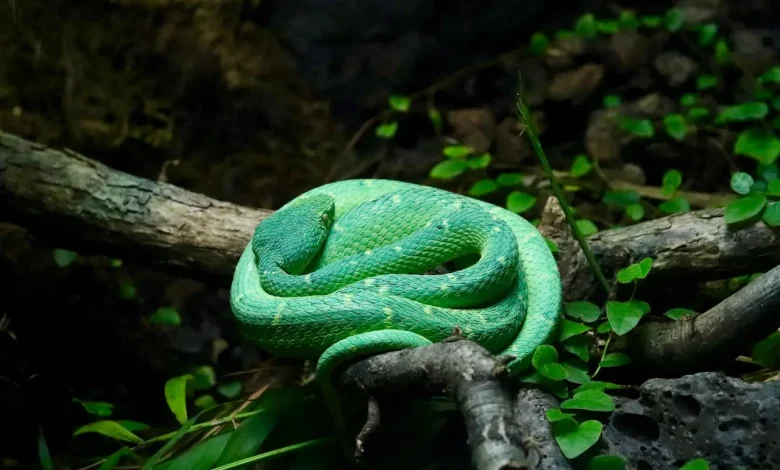
Here are some samples of pages from the Photos of Common Thailand Snakes eBook you can grab for free here. It’s a PDF download.
The following are some of the more common of the common snakes found in the book. Enjoy! Oh, and here is PAGE 2 for even more common Thailand snakes, including some venomous and deadly snakes.
Oriental Whip Snake – Ahaetulla prasina
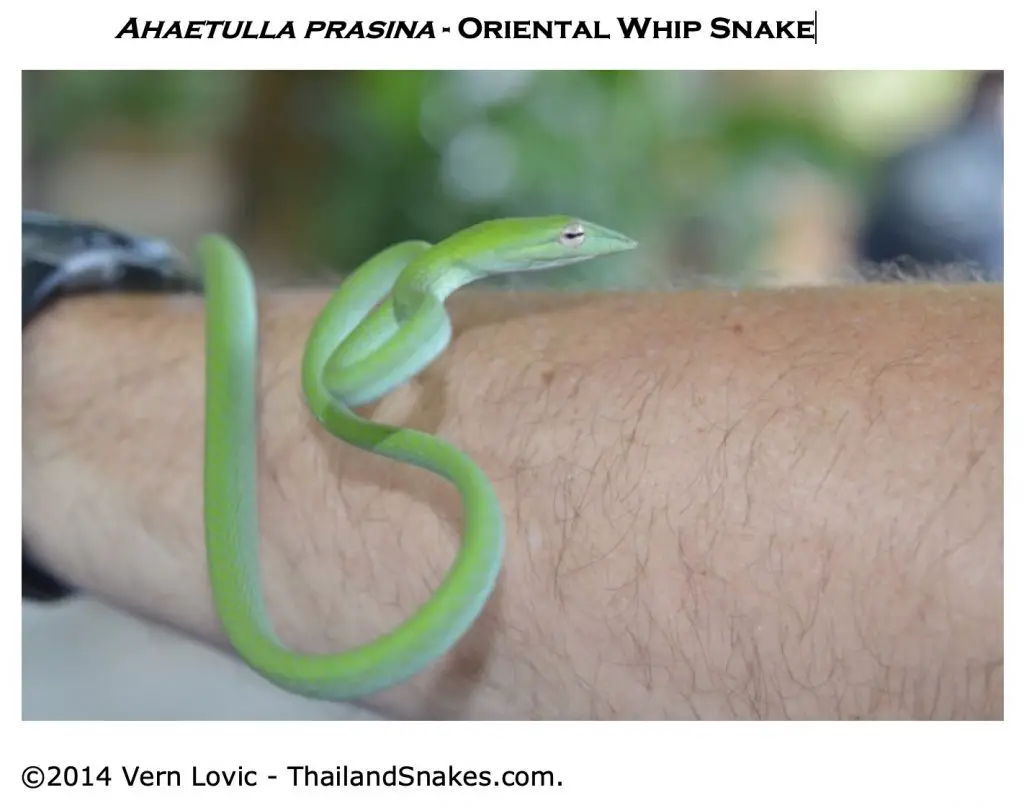
Characteristics of the Harmless Oriental Whip Snake
- Very common, active by day in the trees or on ground.
- Grows to 2 meters and only as thick as a small finger.
- Mildly venomous, but venom doesn’t affect humans. Bites fairly frequently but adjusts to handling quickly.
- Eats lizards, frogs, and other small animals.
- Colors – green, yellow, and grey phases.
The photo above shows the green phase of this snake. There are a number of different phases including – green, yellow, and grey. There are two other snakes that look very similar to A. prasina, they are the Ahaetulla mycterizans (Malayan whip snake) and the Ahaetulla fasciolata (Speckle-headed whip snake).
These snakes are all excellent climbers, and they can be found lounging around on trees waiting for a bird to land. At night they sleep in loose loops high in palm trees or other trees in a place without leaves where they are easily seen.
Below is the yellow phase of Ahaetulla prasina. There is also a grey phase. The green whip snakes are the most common.
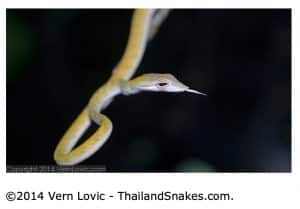
Triangle Keelback – Xenochrophis trianguligerus
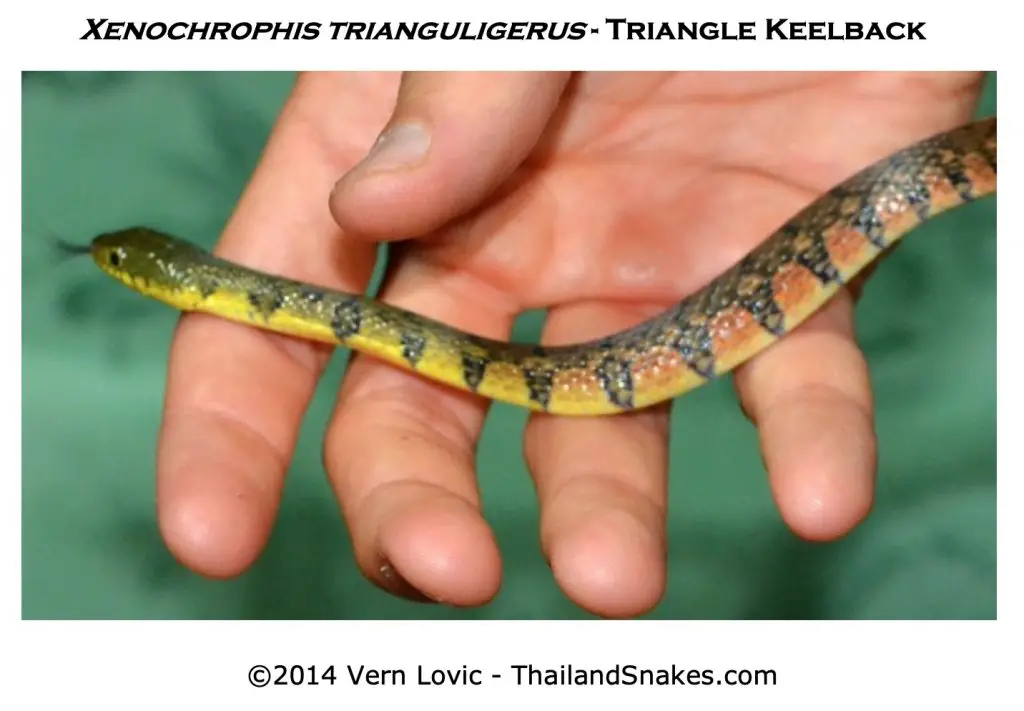
Characteristics of the Harmless Triangle Keelback Snake
- Common around water and streams. Active day and night in or around freshwater.
- Grows to about 120 cm. and 1 finger thick.
- Thought to be harmless to humans.
- Eats small animals found on the ground and in water – especially frogs, fish, geckos and lizards.
- Colors – A multitude of colors including black, yellow, green, orange, pink, red.
I have found a number of these beautiful snakes in Southern Thailand over the years. Invariably they are found near or in water where they sit absolutely still waiting for fish or frogs to come close enough to catch. The triangle keelback will flee immediately if they see humans, so they are easy for us to see at night or during the day. I often find these snakes at night.
The snake in this photo was in the living room of a wilderness bungalow, behind the couch on the floor.
Common Wolf Snake – Lycodon capucinus
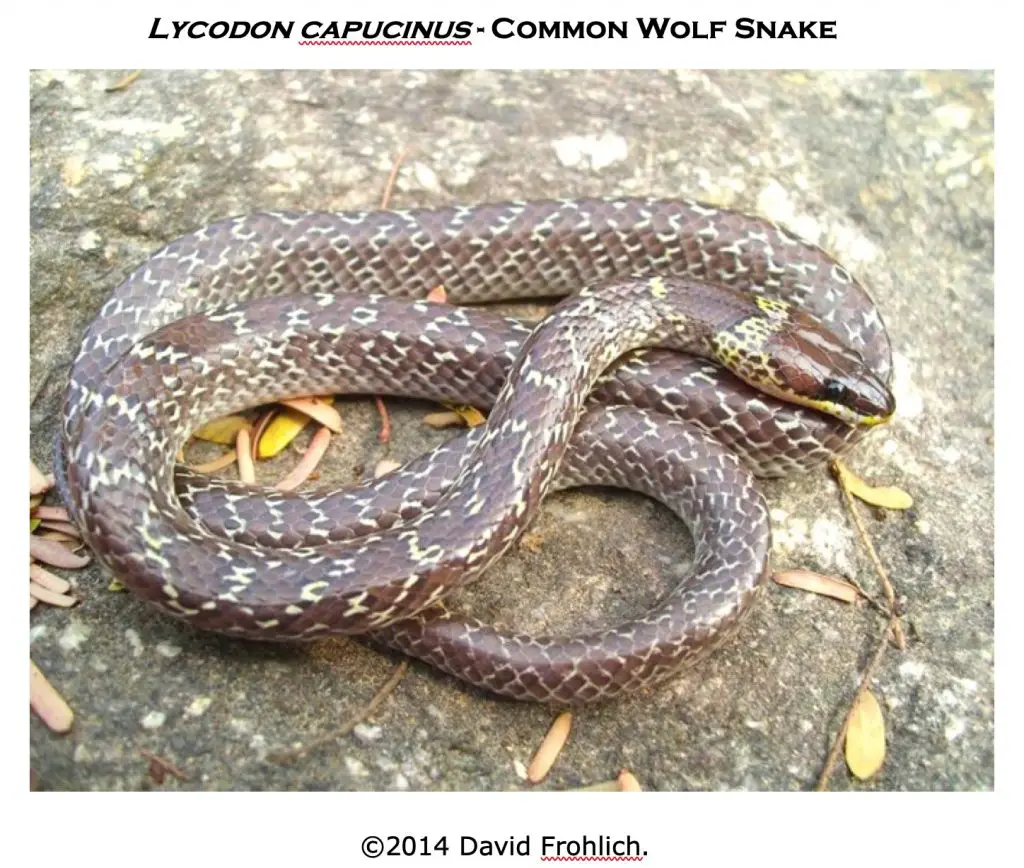
Characteristics of the Harmless Common Wolf Snake
- Very common around homes and in dwellings. Active by night, usually on the ground but recently I found one climbing up a tree around 10 pm.
- Grows up to 75 cm. and 1 finger thick.
- Harmless for humans, and not really an active biting snake.
- Eats geckos, skinks, frogs, and other small lizards primarily.
- Colors – brown or dark, almost black with off-white pattern as shown.
I have found many of these wolf snakes over the years, and I have requests to identify them from visitors and expats living in Thailand constantly.
They are very common in certain places, around bungalows and on porches is where I usually find them the most. Occasionally they are found up in the rafters of homes, and in the beams across the ceiling as they search for geckos.
In the forest, they seem to prefer cruising on or near vertical rock faces. I’ve found them often on stones and inching along carefully on a nearly vertical surface. I’ve also found them on large tree trunks.
Cantor’s Kukri Snake / Kukri Snakes in General
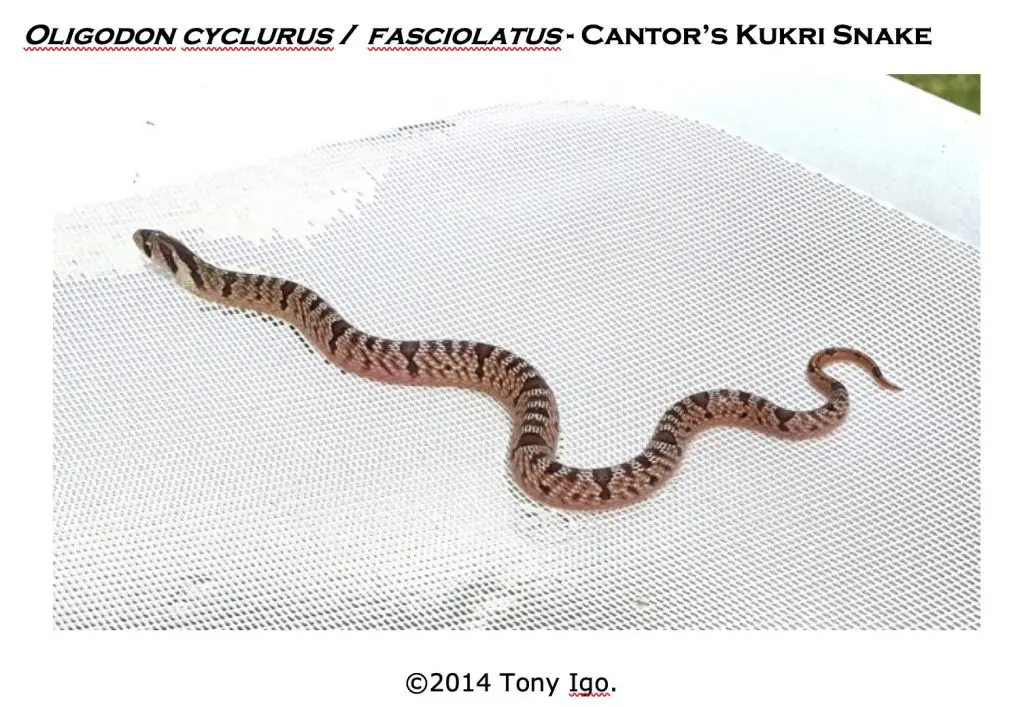
Kukri snakes are very common in Thailand. We get a lot of requests to identify them. Their venom doesn’t affect humans, but they do have large back teeth they use to crack eggs before eating the inside. These teeth are able to come out of the side of the mouth and cause a laceration in the skin of someone holding the snake by the neck or head.
Characteristics of Harmless Kukri Snakes
- Common and active by night or day on the ground and in holes in the ground.
- Grows up to about 115 cm. long and 2 fingers thick.
- Not dangerous to humans, but they do have rear teeth that can come out sideways and slice the finger of someone holding it.
- Eats frogs, eggs, lizards, other animals and insects on the ground.
- Colors – variable green tint, brown tint, cream. The pattern is fairly consistent.
This snake is common across Thailand, and apparently has a pattern that makes people think it is venomous and dangerous because most photos I get are of the snake after beheading or being smashed with a shovel.
These are harmless snakes that eat frogs, eggs, lizards and other animals on the ground. Kukri snakes come in many shades of brown, pink, and orange.
This snake may be O. fasciolatus and not O. cyclurus. Not sure. They look similar and I’ve asked a number of other snake enthusiasts and we cannot come to agreement. Most of the common kukri snakes have a similar pattern, though colors may vary.
Sunbeam Snake – Xenopeltis unicolor
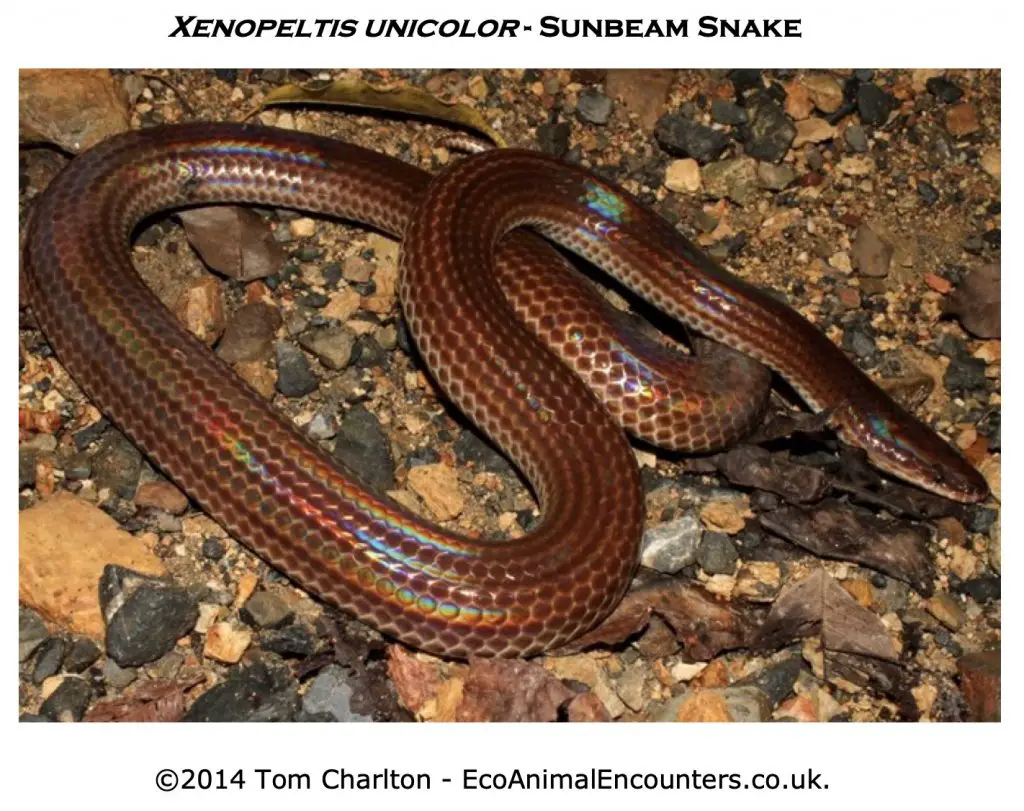
Harmless to man, these snakes are ideal as a first snake to introduce to children or others afraid of snakes. I have only heard of someone bitten by one of these snakes on one occasion, and we’ve handled many dozen of them. I have let my two-year-old daughter play with numerous sunbeam and pipe snakes, and she has come to enjoy them.
Characteristics of the Harmless Sunbeam Snake
- Common and active by night cruising the open ground.
- Grows to 125 cm. long and wrist thick.
- Harmless to humans, and non- biting. Not to say they would NEVER bite, but in 8 years I have not seen one bite.
- Eats rodents, lizards, frogs, and other snakes.
- Colors – shade of brown, either like the photo here, or darker. When shedding these snakes are quite grey. Hatchlings have a white band around the neck.
Sunbeam snakes are so named because their scales reflect a rainbow of colors when the light hits them, especially the sunshine. Here is a snake found at night crossing a path near a stream at the foot of a mountain.
These snakes are not known to bite, and can be handheld – even by amateurs, without fear of being bitten. Though I have heard of one person getting bitten by one – just FYI!
Brahminy Blind Snake – Ramphotyphlops braminus
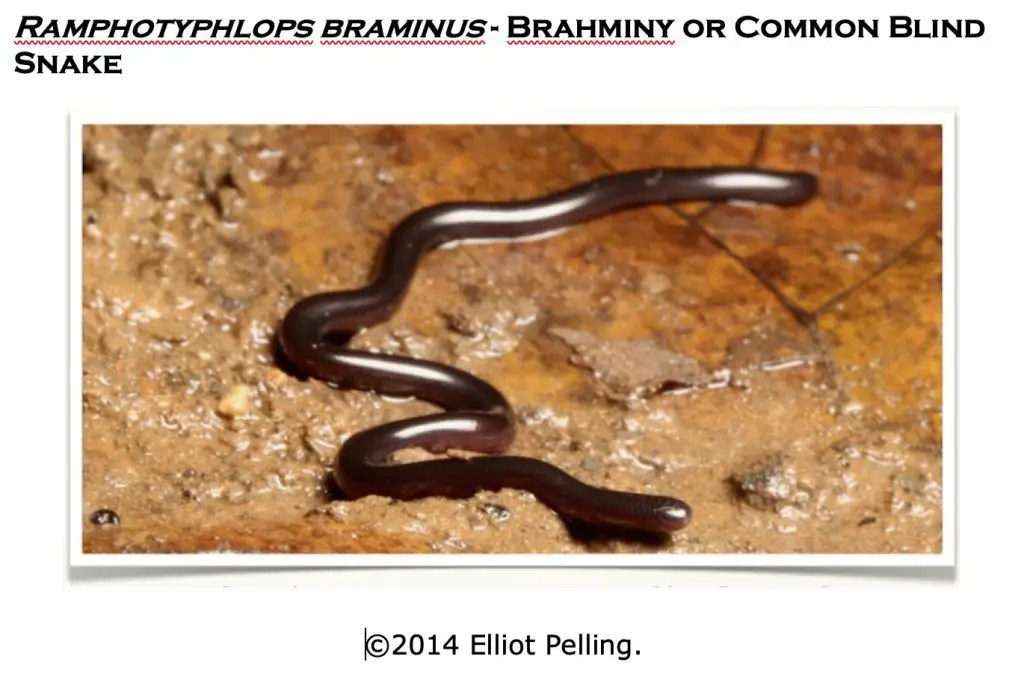
Characteristics of the Harmless Brahminy Blind Snake
- Very common, active by day or night. Spend lives underground, but frequently climb up through pipes into restrooms and kitchens.
- Grows to about 20 cm. long and smaller in thickness than a pencil.
- Non-venomous, non-biting. Completely harmless.
- Eats ant and termite eggs primarily.
- Colors – black or dark brown and with very smooth scales that makes them shiny.
One of the snakes most likely to find its way into your home is the “Brahminy blind snake.” These are subterranean snakes that burrow into dirt, but inevitably find their way up drain pipes and into kitchens and restrooms.
At one place we stayed we must have found 30 of these tiny snakes over a period of months.
This is another snake Thais will swear up and down is deadly. This is probably the most harmless snake in Thailand. Possibly the world!
From Bangkok north and east is also Diard’s blind snake, which looks similar and is harmless.

Thank your for the advice, my cat found a juvenile sunbeam snake but I was unsure what it was until I read here that they have a white band on it’s neck. It was about 15cm long but I rescued it and moved it to a safer place but my wife (Thai) was really freaking out when I tried to show it to her, I had it in a brush pan and it wasn’t big enough even to bite into a finger.
It was different a few years ago when one of our cats pissed off a monocled cobra in our garden, even our Thai neighbours were nervous about dealing with it and the best advice seemed to be let it leave after it had calmed down. We got up in the morning slightly nervous and thankfully it was long gone.
Had another cobra in the garden a bit later, my oldest cat found it and went for a closer look and it just lifted it’s head and looked at the cat cat & me so the cat decided to retreat but the reason I mention this that I was about 3m away and I could see the full length. My estimation was it was nearly 2.5m long but from what I’ve read only king cobras grow longer than 2m and it wasn’t a king cobra. It wasn’t a rat snake as I’ve many encounters close up with them before we had rescue cats and they just shoot off so fast.